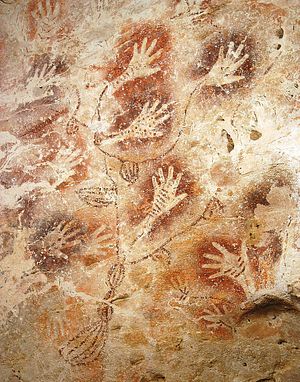Indonesian and Australian scientists have confirmed that cave art found on the Indonesian island of Sulawesi is approximately 40,000 years old, pushing back the date of humanity’s oldest art by a couple of thousand years. The art, made from the ochre pigment, included hand-stencils and paintings of local animals, such as the pig-deer or babirusa. According to reports, “the paintings adorn the walls of caves and shelters at the foot of spectacular limestone towers that rise up from the surrounding rice fields near Maros in southwestern Sulawesi.”
Archaeologists discovered the Sulawesi cave paintings 60 years ago but assumed that the art was no more than 10,000 years old because they thought that the tropical environment would have destroyed anything older. Such assumptions do have a legitimate scientific basis; human creations that are exposed to hot and humid weather tend to decay or fade away swiftly. However, assumptions can also be dangerous because they are not always correct. According to Matt Tocheri of the Human Origins Program of the Smithsonian’s National Museum of Natural History, until the present research, “the truth of it was, no one had really tried to date it.”
The art that was previously considered the world’s oldest was found in a series of caves in France and Spain. This led to the view, now obviously incorrect, that “cave painting was part of a suite of complex symbolic behavior that humans invented in Europe.” Since most early archaeologists were European and worked initially in Europe in the 19th and early 20th centuries, it is natural that the first cave paintings were discovered in Europe. However, this fact also undoubtedly led to a Eurocentric bias – some of it subconscious – toward early human achievements such as the origin of art. Although Europe does have a favorable combination of climatic conditions and scientific institutions that make the discovery of ancient artifacts there easier than in other places, this does not imply that there are actually more (or more advanced) works of ancient art and technology in Europe. Modern technology and increasing funding mean that many more ancient discoveries are likely in Asia and the Middle East. According to Nature, the Indonesian discovery “could prompt a ‘gold rush’ to find even older art on the route of human migration from Africa to the east.” It is also quite likely that already known art may also be re-dated to be older than previously believed.
The Indonesian and European paintings resemble each other thematically: they show human body parts and animals but reveal different techniques. The European paintings “look dabbed, almost like finger paint” while the Indonesian paintings “look ‘line-y,’ almost like brush strokes.” Such divergences imply that art had been evolving for quite a while and had deep origins, perhaps from the time humans when left Africa. The fact that art probably appears everywhere our species went debunks the notion that “that early Europeans were more aware of themselves and their surroundings” and makes it likely that “artistic expression was a fundamental part of human nature 60,000 years ago, when modern humans not only occupied most of Africa but were beginning to disperse out towards Europe and the Far East.”
It is clear that there is still much to be discovered about human prehistory as well as early history, especially in Asia, which is home to some of the world’s oldest human populations and civilizations. Increasing wealth and motivation make it more likely that there will be further discoveries and research on these discoveries and indeed, every year there are several exciting discoveries. This applies not only to archaeology but to history, the creation of which requires concerted effort to take existing archival resources like records, chronicles, and administrative documents and turn them into conscious history. It is to be hoped that future discoveries in Asia continue to transform our understanding of the human experience and human history.

































